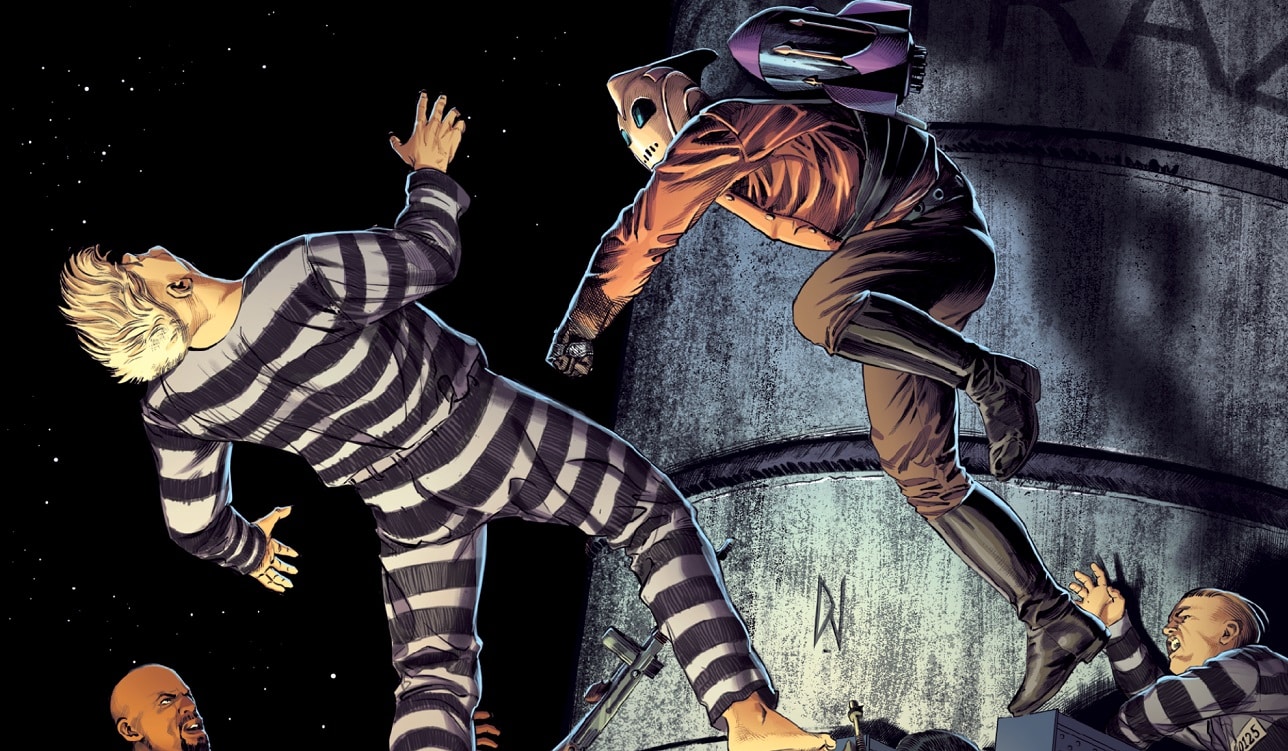Joe McCulloch | October 29, 2024
 Published by Top Shelf & Knockabout, 352 pages, $49.99. Please note that all spellings of specialized terms below are used as they appear in the work under review.
Published by Top Shelf & Knockabout, 352 pages, $49.99. Please note that all spellings of specialized terms below are used as they appear in the work under review.When I was 19 I could predict the future, but only for stupid reasons. If I was supposed to go on a car trip with friends over the weekend and it did not seem clear whether the trip would happen or not — situations like that — I would dream with some regularity of what would happen, and the dream would be correct. But I would never exactly "see the future" in such dreams; rather, I would dream (say) of myself standing at a terminal in some airport, coaxed toward the gate by an inevitable nudge, and though I was not going to fly anywhere in real life, I would understand immediately upon waking that the car trip would absolutely happen.
Reflecting on this, I unfortunately do not detect any incubation of divine insights. What I presume happened was that my subconscious mind would calculate probabilities in a way I could not do while awake because of the bias added by emotions I would attach to events in the waking world; my dream would present the results as a sort of pageant, as if to misdirect my apprehensions of the everyday. Placed at a fictive remove I could accept these calculations immediately and know the future. I never had any difficulty interpreting such dreams, I just knew. But I stopped having them a short ways into my 20s. I suppose we stop feeling things so intensely after a while that the force of destiny no longer hangs over car rides. Like the Amazing Criswell once insisted to a confidant, I "had the gift, but I lost it," and I was surrendered therefore to the future, where you and I are going to spend the rest of our lives.
Yet if we entertain the idea that humans are "a four-dimensional continuum projecting through a solid spacetime medium that is eternal and unchanging," Block Time Theory as phrased by The Moon and Serpent Bumper Book of Magic, we might imagine that our minds can pause every so often in the frozen comic book panels that form the sequence which is our lives and consider the whole page. It would only be our imagination, we would know, to which this book would add: "Yes, and that's why it's real."
 Spot illustration by Rick Veitch.
Spot illustration by Rick Veitch.Pentacle in hand, I will begin by addressing earthly concerns. This grimoire has been long awaited by admirers of the comics professionals involved, though it is mostly illustrated prose; of its 352 pages, less than 70 are comics. In this way, the Bumper Book can be read as the latest in a prose renaissance for one of its authors, Alan Moore, who published another long-brewing work, his massive novel Jerusalem, in 2016, which he followed with a story collection, Illuminations, in 2022, and the first volume of a fantasy novel series, The Great When, a bit earlier in this 2024. The Bumper Book also marks the return (in fitting defiance of the flesh) of author Steve Moore, who died in 2014 as the final portion of the manuscript was being drafted by Alan Moore (who, per his own account, is responsible for all on-page writing, following much research and consultation with his co-author). S. Moore and A. Moore are not related, but they have known each other since the 1960s. S. Moore, the elder of them, was a pioneering figure in U.K. comics fanzines and convention organizing, who collaborated with A. Moore on some of his earliest strips in the music weekly Sounds and devised an influential series of twist-ending short comics for the nascent 2000 AD. S. Moore worked irregularly in comics through the '00s, but was also a scholar of the I Ching, a key figure in the founding of Fortean Times — for which he was a longtime writer, editor and cataloguist — and, importantly for our purposes, a magician whose impact on the younger A. Moore is detailed in the latter's 2006-12 biographical-essay-turned-collaborative-multimedia-project Unearthing.
In Unearthing, A. Moore evokes literary theorist Tzvetan Todorov's concept of the fantastique as "a literature of hesitation that refuses to decide between a rational or supernatural resolution" to describe the situation of his co-author in the 1970s, after S. Moore began dabbling in magic and was greeted by a whispered voice in the dark of his bedroom. The practice of "magic" as described by the Moores needs not resolve whether the voice is "real" or imaginary - instead, it theorizes human consciousness as a way station between the cognitive and the imaginary, which are both "real." Or, to quote the authors' introduction to the Bumper Book, pg. 16:
Might it be useful, without contravening any laws of commonsense or physics, to suggest that the domains of mind and matter are both real, but in completely different ways? Isn't it possible that all the extraordinary claims made on behalf of magic are entirely credible providing that one understands the magic to be taking place nowhere save in the mind?
Of course, if we describe something as being 'in the mind' we generally mean that it does not exist. To show that this is not in fact the case, we must examine both our notion of existence and our notion of the mind, as well as looking carefully at the relationship those two things have to one another.
I trust I don't need to belabor here that by "magic" I don't mean Criss Angel, Mindfreak, but the kind of magic that is sometimes spelled with a 'k' on the end, although the Moores assure us in the Bumper Book that we don't need the extra letter; that was mostly a product of Aleister Crowley's regimen of self-promotion, premised on dubious numerology. Much of the book's tone is like that: not exactly a skeptic's book of magic, but prone to reminding the reader that the terrain of the imaginative is behind a door of cognition that is the reader's own. In opening the door, "allowing that this portal and the realm beyond it might conceivably exist," and moreover allowing for the presence of an Archetypical World, "private mental landscapes open[ing] onto a far broader landscape that is common to us all," the shaman, sorcerer, magician, can be defined as those who "claim success in entering into a more productive and active relationship with consciousness."
If you are familiar with the works of A. Moore, you might expect a great deal of self-referential diving in and out of narrative forms to result from this tension, but in spite of some of that, the Bumper Book is notable for how straightforward it is. It is dressed as an antique children's annual of stories and novelties, though it becomes immediately evident that the "bumper book" costume is there to signify that this is an primer - an edutaining guide to magical concepts and practice for the layperson or those superficially familiar with the occult, such as myself.
You will definitely be asked to do some deeper thinking by this book, because it prioritizes magic as a process of thinking. When you are practicing magic you are thinking very, very hard. If you were raised in the church of Rome, as I was, you've already had a glancing familiarity with all of this when you held the beads and recited the Rosary, fixating on the Glorious Mysteries while chanting Marian prayers which you had assuredly committed to heart so that the repetition focuses rather than distracts. Surely, too, you heard of bedridden visionaries transported to the Crucifixion from their altered state, or sainted Teresa of Ávila, encountered perhaps in Eat, Pray, Love, sequestering herself for years in prayer and thereafter conceptualizing the soul as a mansion of seven courts progressing toward unity with God. But the Moores would draw a strict distinction between "prayer," which begs the intercession of an outside dominant force, and magic, which deliberately connects oneself with such imagined (and yet therefore real) forces.
 Page detail; art by John Coulthart, introducing the Tree of Life. Smaller, simplified versions accompany most pages of the Bumper Book's section on Kabbalah, with particular sections colored to guide the reader's travel.
Page detail; art by John Coulthart, introducing the Tree of Life. Smaller, simplified versions accompany most pages of the Bumper Book's section on Kabbalah, with particular sections colored to guide the reader's travel.To this end, the Bumper Book is divided into dozens of often-linked sections describing aspects of magical history or practice. Not a few mirror one another. For example, there are two large sections on Kabbalah and Tarot, their descriptions of the Sephiroth of the Tree of Life and the Major Arcana – heavy with correlations between the two – as well as the Hebrew alphabet, the classical planets, alchemical qualities, the occult practice of the Hermetic Order of the Golden Dawn, etc. While the text can be consulted by topic, this book is best read from front to back, as some later sections benefit from one's familiarity with more elementary concepts discussed earlier. Six sections, for example, carry the title "Things to Do on a Rainy Day" — an allusion to children's games as well as the paleontological theory that Northern European civilization may have developed from Neolithic people suffering "cogitative boredom" while sheltering from bad weather — and focus on different areas of magical practice, with building complexity: magic as art; the cultivation of altered states; magic as "transgression"; mental projection; evoking vs. invoking entities; and practical applications of magic.
In pragmatic terms, this amounts to a great deal of intense study and then a great deal of contemplation upon that study, by which the practitioner can, for instance: (1) brandish a magical implement ("symbolic tools for concentrating the magician's mind on certain necessary human attributes") they have built or obtained; (2) cordon off one's mind with a 'banishing ritual' (a system of focusing gestures and statements, e.g., the Golden Dawn's Kabbalistic Cross); (3) swallow some psilocybin mushrooms (though "if one feels the least uncomfortable about the notion ... know that in such matters your own judgment reigns supreme"); and (4) focus one's self upon a patron deity, perhaps through a visualization of that deity which you have prepared, or the recitation of incantations ("[b]y deliberately using language in a way that to us seems abnormal... we help tip our consciousness over the edges of our customary rational mind-set and into the alien landscape of ideas that is the world of magic."). In doing so, one may seek to glimpse not only a wholly personal library of images, but archetypical places and beings observed throughout history. As for what may result (pg. 53):
If the ritual has in your opinion failed, then make suggestions as to how you might improve things next time, although do not judge your 'failures' too hastily; a dream or meditation or hallucination that seems meaningless might suddenly gain relevance when you've acquired more occult knowledge. On the other hand, be wary of attributing too much significance to what may have been only fleeting fancies. Simply write your observations down. Evaluate them later.
If results have been especially encouraging, perhaps suggesting actual contact with a deity or spirit, that is when you most need to remember what we told you earlier about the two ways ritual can be regarded: if the gods are independent entities, then you have just encountered something wonderful. If on the other hand the gods are parts of our subconscious, then the same is true. You have encountered something wonderful, and should be just as grateful in each instance. Just remember that you have no obligation to decide on whether the experience is psychological or supernatural. A sceptical approach is probably the best, and will do much to ward off any dangerous obsessions.
This is a book that seeks to answer the question of "is God real?" with a forceful yes and no. To offer an example of my own, Jack T. Chick's faceless God is not sitting in the sky above with an angel on standby to check off every dirty joke you have told before plunking you into the Lake of Fire, but in rendering God as a featureless being, these authors might say Chick positions Him as akin to the absolute godhead Kether, hermaphroditic crown of the Tree of Life and, analogously, the Primum Mobile in Ptolemaic astronomy, devoid of characteristics save for that which it moves, so that the God of a Chick tract manifests from an archetypical form. Or, to quote directly from the Moores, gods, demons, angels may be "creatures with a skeleton of concept and their flesh formed of associations and ideas, just as our own corporeal bodies are composed of tissue, bone and other physically manifest materials," or, alternately, "some amorphous and supernal animating force or energy that in itself possessed neither form nor an identity but which, in its proximity to human minds, will fill and seem to vitalise whichever mythic or symbolical conceptual vessels we present to it." The former seems more likely to me, in the way that one might converse with somebody in a dream as if they are a separate person from you, although they are actually a product of your mind. It follows, then, that the mind can be trained to carry ideas of sufficient complexity that they can communicate with you independent of the conscious mind, asleep or not. Comics readers may think further to the Unifactor, described by the artist Jim Woodring as both the setting for his Frank comics and a sort of algebraic system that dictates the stories of those comics independent from him.
A question arises: if the flesh of a god is formed of associations and ideas, is that skin not marked by the cultural presuppositions and latent biases of the associator? Decades ago in the print edition of this venue (#252, May 2003), in reviewing Promethea — A. Moore's magic-themed 1999-2005 comic book series with J.H. Williams III, Mick Gray and others — the writer Tom Crippen quoted Montreal retailer, comics scholar and art curator Marc Jetté to the effect that Moore had, in matching Western European studies of Tarot with human history, inadvertently suggested that Western European history was human history. At several points in the Bumper Book, the Moores emphasize that while the notion of an illuminated, archetypical world recurs in various cultures, they are only specifically discussing the Western magic tradition here, albeit with occasional references to Hindu tattvas, the aforementioned I Ching or the concept of the Loa in Voodoo, which the authors immediately disclaim as "a complex magic system in its own right and therefore beyond our remit here." As a result, there are only glancing mentions of Asian, Islamic, Caribbean or various Indigenous esoteric traditions, any of which would make for an interesting comparison in the future.
 Page detail; art by Ben Wickey, illustrating scenes from the life of Aleister Crowley.
Page detail; art by Ben Wickey, illustrating scenes from the life of Aleister Crowley.The great virtue of this book is its accessibility; I found it a concise guide to a variety of esoteric topics, organized with a good sense of intuition. This is creditable to not only the authors, but its predominant visual force, John Coulthart, an artist I mostly know through his extensive involvement with Manchester's Savoy Books as a designer, illustrator and cartoonist, though he has been a consistent presence in Moon and Serpent projects though his album art for A. Moore's live performance works with the musicians Tim Perkins, David J and others (The Highbury Working, Angel Passage, etc.). Here, Coulthart is credited with the Bumper Book's overall design, its cover art, large illustrations for nine different sections and many spot illustrations throughout. Sections are differentiated often by page color — white, blue, several shades of brown — while individual illustrations repeat themselves on successive pages to prompt the readers through the authors' esoteric thickets: the image of the Tree of Life repeats page after page as the Moores run down its branches, each of its 10 emanations glowing one by one by alchemical color as they are discussed; Tarot cards are displayed both as in the Tarot de Marseille and in iconographic forms devised by Coulthart himself, running along the tops of pages for quick reference. Decorative borders on most pages pulse dim to strong on a gradient; colors glow cold under glassy digital frost, which is not my favorite look, but further imposes unity on the book as if from an aloof mechanical Demiurge.
A few of the spot illustrations are done by longtime A. Moore collaborator Rick Veitch, immediately differentiated from Coulthart not just by his recognizable line, but from the touch of weird Americana his clean-cut child characters bring to a very extremely British text; scenes of cub scouts constructing a junkyard god or a boy's jaw hanging loose above his V-neck while automatic-drawing a squid traffic in much the same juxtaposition as Veitch's ongoing Maximortal comics. Another U.S. artist, Ben Wickey, handles the great majority of the Bumper Book's comics via 50 one-page episodes of "Old Moores' Lives of the Great Enchanters," which encapsulate practitioners, organizations and influential adjuncts from the Western magic tradition, including imaginary or composite figures (e.g., Simon Magus, Christian Rosenkreuz) of particular importance. I am unfamiliar with Wickey's work, though I understand he has a background in animation; a few of the shorts adopt cinematic characteristics, such as positioning a character in the same position in each panel, 'animating' him slightly while his surroundings reflect vast jumps in time and place, but most of these strips take the form of very straightforward, sometimes photo-referenced captioned biographical comics, simple to read from the concision of the text and the sturdiness of the character art.
These strips are joined by "The Adventures of Alexander," a longer, eight-page biographical serial scattered one page at a time throughout the book, dedicated to Alexander of Abonoteichus, "the first archeologically verifiable magician" and an inveterate charlatan. He is best known to comic book readers as the inventor of A. Moore's patron deity, the Serpent of the titular Moon and Serpent – the snake puppet Glycon, a wholly artificial, theatrical god beloved of the Roman Empire in the second century. In stark contrast to the more stolid narration of "Lives of the Great Enchanters," this serial is a pastiche of 20th-century British children's comic papers of an educational bent, narrated with supercilious japery and loaded with bullshit. This opportunistic quality is incorporated into the story itself as we are eventually reminded that the only surviving narrative of Alexander's life comes from the satirist Lucian of Samosata, his account laden with comic ridicule. Appropriately, these pages are drawn by the late, great Kevin O'Neill, working in the caricatured style of his and A. Moore's Cinema Purgatorio, colored by one Romain Janicki and lettered by longtime collaborator Todd Klein. In drawing attention to (and making a narrative device from) the artifice of its construction, these pages are perhaps the most "Alan Moore" of the book, although this partial reunion of the team behind The League of Extraordinary Gentlemen also brings to mind the very dense text accompaniments to many of those comics, intent on drawing connections among scores of fictional characters - the fascination with concordances that form the conceptual landscapes of the imaginary in the Bumper Book are driven by a not-dissimilar restless study.
 Page detail; art by Kevin O'Neill, colored by Romain Janicki, lettered by Todd Klein.
Page detail; art by Kevin O'Neill, colored by Romain Janicki, lettered by Todd Klein.But then, what of Steve Moore? As mentioned earlier, he does not appear to have drafted any of the prose in the Bumper Book, but we might still detect his specific presence peering through the curtain of research. As the Kabbalah section is complimented by the Tarot section, and the "Lives of the Great Enchanters" comic is offset by "The Adventures of Alexander," so too are the instructive "Things to Do on a Rainy Day" sections matched by a similarly six-part work of serial prose fiction, "The Soul," which imagines those concepts from each of the "Rainy Day" pieces put into practice by Adeline, a glamorous layabout in 1920s London introduced to magic while modeling for an older practitioner's portrait of Actaeon peering upon the nudity of lunar goddess Diana – a vignette also envisioned in S. Moore's 2011 novel Somnium. Selene, the Titanian embodiment of the moon in Greek myth, is S. Moore's patron deity, the Moon of the Moon and Serpent, and I regret I cannot offer cash prizes or sweet kisses if you have guessed by now that the Moon and the Serpent are complimentary forces in the way so many sections of this book engage in dualism, feminine and masculine symbols intertwining, "our central icons in their most exalted form as universal powers, symbols of creation which transcend the human world and even that of physical existence; generators of all being, physical and metaphysical," per the impassioned authors.
"The Soul" is very lunar in its symbology, though it gleams a bit purple: "The Moon-bride could feel the racing steed of her own passion, thundering between her straddling legs as it approached the stretched tape of a finish-line that was her looming crisis, spurred on by the burning knowledge that it was her dearest kin she had shoving and shuddering inside her." While affording the book some practical examples of magic at work, it more often feels like a lark, particularly for the authors. Following the "Rainy Day" segment on transgression, Adeline finds herself transgressing against her ostensible homosexuality by engaging in a many-positioned fuck fest with the aforementioned elder magician ("not a quarter of an hour later, they had cast off all notions of discipline or magic practice and had simply gone one at the other like a pair of hungry beasts").
By the time Adeline is overtaken by fury and strikes terror upon the local lesbian scene by misusing the quality of decisive justice emanating from the fifth Kabbalistic Sephira, Geburah, for the undirected rage of its Qliphah, a negative mirror reverse which all Sephiroth have, the text ventures perilously close to that meme where an ordinary person sees a turkey roasting inside an oven while a creative person sees a dragon breathing fire onto a turkey inside an oven, etc. Heaping abuse upon herself some time later, the heroine is confronted by the demon Lilith, which she dispels as a sort of embodiment of her own disquiet. Presuming the text was mostly complete by 2014, the Moores thus anticipate a renewed appetite for horror fiction powered by monsters of trauma, e.g., The Babadook from that same year, if we are thinking in terms of professional reward.
"But should we?" ask the men behind the curtain.
 Page detail; art by John Coulthart.
Page detail; art by John Coulthart.The practicalities of magic, the "what it all does," is a tricky enough subject to command extended attention toward the end of the Bumper Book. I suspect we all can imagine one million ways in which treating the imaginary as real can go catastrophically wrong for the wider society, and the Moores' means of protecting against that is prosecuting a severe pride in connoisseurship and mastery. The Bumper Book is dotted with notes of distaste for the facile likes of the New Age movement ("a patchwork of cherry-picked and emphatically old-age ideas culled indiscriminately from supposed Native American beliefs, Arthurian legend, Celtic myth, Mayan antiquity, and misapplied or willfully misunderstood concepts from quantum physics"), Wicca (emergent from "escapist romanticism and [a] sense of middle-class entitlement"), the Ford F-150 esotericism of QAnon ("[i]f we do not keep the blade of our discriminating intelligence polished to a fine edge, then we lose the ability to discern"), and, especially, the UK-born concept of Chaos Magic, which is critiqued at some length as "an extension of fantasy fandom" for its invocations of characters from popular fiction, "trivialis[ing] and infantilis[ing] the field by seeking to reduce it to a practical commodity," its drafting of sigils to produce concrete benefits "representing more the sense of effortless entitlement prevailing in late-20th-century Western culture rather than a genuine attempt to progress magical ideas into a form more relevant and adequate to the 21st century."
To combat this, the authors draw a distinction between "high" magic, "the urge towards greater understanding, transcendent experience and the ecstatic enhancement of consciousness," and "low magic ... the attempt to bring about desired changes in material reality that are to the magician's personal advantage." In advocating for high magic, the Moores urge the practice of magic for magic's sake, whereby personal, creative, intellectual boons present themselves as if guided by magic itself, "the practitioner left marveling at an abundance of results that he or she had neither asked for nor expected." Render therefore unto Caesar the things which are Caesar's, to add an inappropriate note of my own. The "Great Enchanters" of the comics in this Bumper Book are often buffeted by politics, but they are not usually individuated as activists; rather, magic itself is treated as an expression of anarchy – the promotion of unmediated self-governance vs. the compulsory obedience of doctrinal religion. That magical orders have tended to regiment into elitist fraternities and doom cults does not dim magic as "a subjective practice of the individual, a means by which a single self may come to its own understanding of and make it its own peace with the wonderful and terrible phenomenon that is existence." Importantly, the work of "material" security is a condition precedent to magic practice, because “if we do not have our material circumstances under our control it will be difficult, if not impossible, to progress spiritually.”
Lucky we have so much time to read! But this position is very much in keeping with the professional career of A. Moore, who has disclaimed participation in any work that he cannot own. It is not spells that will help you there, it’s a rare degree of intractability. The coin, we are told many times, is the elemental weapon of earth. Unless you are very fortunate, you will have to live and work in precarity, as a renter eking out your sustenance from things your boss owns, and the material world is best addressed in material terms, lest we cast a shimmering glamour onto our chains and believe ourselves held in the talons of angels.
I don’t really think of low magic in terms of anyone who’s so much as heard of Austin Osman Spare, much less misusing his occult practice. I think of incantations cast deep into the Spectacle. I am online way too much, so my idea of this ill enchanter is somebody speaking algorithmically guided words spoken in a particular voice for maximum engagement. When the ill enchanter posts to X, the Everything App about how a nuclear strike upon U.S. cities will restore "productive" racial demographics, they are pressing buttons to perform a combination in a fighting game online. Maybe it helps to believe some of it, as a means of charging the spell, but all you are really doing is coding, getting the program to reward you, Lilith wriggling her anime tentacles and pennies falling from Heaven. And when the sky is thus swollen, you are encouraged to think of these novel arrangements of categorized sensations as the sum of human endeavor, perfectly reducible to mathematics, and staring hard enough at the wall, you begin to see the 010010100 behind the paint and then, turning to a mirror, you understand the persona you are cultivating now is but numbers you add up to form all that is what you are. That is all you fucking are. You open the door and leave the room and you are in another fucking room.
"A disease of language," as Crowley called magic. All these Sephiroth, Tarot cards, etc., are treated here as grammatical units. Far off on their hill, the high mages try to break everything back down.
 Page detail; art by Steve Parkhouse.
Page detail; art by Steve Parkhouse.At the very beginning of this book, there is a wordless eight-page comic by Steve Parkhouse, titled “The Morning of the Mind.” An ancient man is out hunting with his tribe, and is slashed in the leg by a stag’s antlers. He is sickened, hallucinates, but does not die. Pressing bloody palms to a cave wall, he fashions the shape of the stag from his burning memory. His tribe places the antlers of the eaten animal upon his head. This is the birth of human consciousness, ascended from animal instinct: the visionary thought become image, the first “language,” magic at the dawn of civilization.
A. Moore has said that this book is “intended purely as a statement about magic, rather than as a statement about comics.” But if art is magic, and comics are art, then this is also a book about comics, one that positions the drawn image, the picture story, as fundamental to social beings. This romance feels like a way of raising the art far above the mess of its mercantile circumstances, the shell which too often defines it, the mess from which he fled, a comics that is not just cruel tricks to cop money from suckers, comics preserved in the sky with wizards to voyage far on the silver foam of dreams.
* * *




















 English (US) ·
English (US) ·